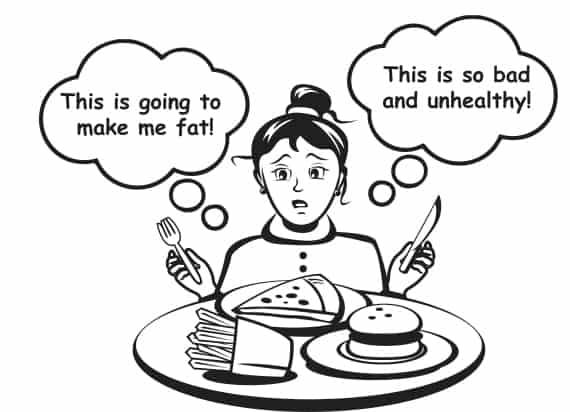Leaving Judgements Behind Makes Us More Mindful Eaters
Meet IzaanAli, my three-year-old. He loves his food and you can see just how much!
Healthy toddlers are naturally mindful eaters. They are aware when they are hungry and stop eating when they are full. They engage with their food and savor every bite!
But that is not the case for the majority of us…
How many of us find ourselves sitting in front of the television or computer whilst eating our meal? Before we even know it, we’ve completely finished. Do you remember what your last meal tasted like? Some of us may not even recall eating it.
Sound familiar?
I reckon many of us have experienced this lack of awareness or memory lapse at some point. With long days at work, busy lives, and food available everywhere we turn, eating is often done mindlessly.
The result?
We eat more! Mindless eating can lead to weight issues, ill-health, and an unhealthy relationship with our body and food. Such absent-minded eating habits prevent our brains from capturing the memory of what we ate. We continue to eat more throughout the day in search for the satisfaction-factor.
What’s the solution?
Growing evidence shows that mindful eating could be the answer. Yes, mindless eating versus mindful eating. It is that simple! What’s more, this practice of savoring our meals with greater awareness has benefits beyond the physical.
So, what’s mindful eating?
Mindful eating is having a greater connection with your body and with your food as you enjoy the experience of eating with intent and attention. It’s about leaving judgements behind, discarding the labels we may attach to our bodies and food.
Any of these ring a bell?

Discarding judgements and labels at meal time
So this mindful eating business sounds pretty great right? So why aren’t more of us practicing it? Is it because we perceive it to be painstakingly time-consuming and unrealistic?
As a working parent with young children, my mindful eating practice doesn’t involve sitting down for 30 minutes at every meal. Nor do I expect calm and serenity at meal times to engage with the experience of eating. There are no hard and fast rules. I have accepted the fact that happy chaos is the norm. The important element for us has been eating with intent and attention. And yes, you can achieve that even when life is chaotic!
I believe mindful eating doesn’t have to be hard. As you sit and eat your next meal, consider practicing these eight tips to cultivate a more loving, nourishing relationship with your food and with your body.
-
Recognize true hunger.
It is important to identify if you are truly hungry or if it is an emotional desire. I often say to my patients, “If you eat to fight emotions, you can never win!” Simply said, food can’t satisfy emotional hunger. Eating may feel good in the moment, but the emotions that triggered the eating will remain. True hunger is physical and usually starts in the stomach. Recognize the signs and eat when you are truly hungry.
-
Less time? Less food!
Portion your food based on the time you have to consume it. It’s important to avoid rushing through your meal and feeling hurried. Take the time to enjoy a smaller portion mindfully.
-
Breathe in. Hold. Breathe out.
This is preparation to calm your mind and ground yourself before eating. This is an important step in preparing you to engage with your body and your meal. This will help to centre you from a “human doing” to a “human being.” Deep breathing is a powerful tool to heighten our senses and awareness at mealtimes.
-
First, eat with your eyes.
Notice the food on your plate. What does it look like? What are the different textures? As a family, we often try and guess every ingredient in the dish. This helps us engage with our food and keeps our attention on our meal.
-
Consciously chew.
Take the time to chew well, and enjoy the release of flavours from every bite. What’s more, you’re likely to notice when you are full. Gulping food down without chewing can trigger unpleasant symptoms, like bloating, gas and indigestion.
-
Tune in with your fullness scale.
Consider rating your level of fullness from zero to 10. Zero means “I’m starving” and feeling overstuffed equals a 10. Aim for a seven, and avoid being at the far end of either side of the scale.
-
Silence the mind chatter.
This can help train your mind and body to be compassionate, non-judgemental and to enjoy being present in the moment. If you are having difficulty controlling your thoughts, make a note of what is distracting you. Park it! You can always return to it after your meal.
-
Offer gratitude.
Take the time either before or after your meal to be thankful. Counting your blessings is yet another way to bring attention to the present moment. It brings positivity to your experiences and boosts physical and mental health.
Remember, mastery comes with practice. These eight tips will help set you on your journey to become a mindful eater — even more like a toddler perhaps!
This blog was originally published on The Huffington Post. Click to read.







These are such great tips with an especially adorable picture! Mindful eating is so important and these are such good reminders!
Thanks so much Nicole 🙂 His funny expressions are quite entertaining!
Great post! I’m such a huge proponent of mindful eating. It’s so important, yet something that our society seems to be getting more and more away from. Also, your son is adorable!
Love all these mindful tips!! I especially like #2 – it makes so much sense! Great post!
Thanks Katie! Tip 2, I think is one of the easiest to implement from the list.
Love these mindful eating tips! I’ve been trying to be more mindful at meals lately so I found this very useful!
Thanks so much Whitney! How has it been going? Love to hear about your journey!
He is so sweet and adorable! And love the post on mindful eating, such an important topic!
Thanks Emily. He is one CHEEKY monkey!
This is a great guide to mindful eating! And I love that picture!
Thanks Jessica! It was a lucky shot 🙂
Never thought about the portion out tip! Good one!
Thanks Abbey!